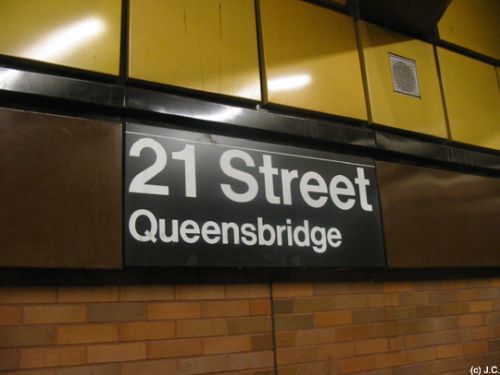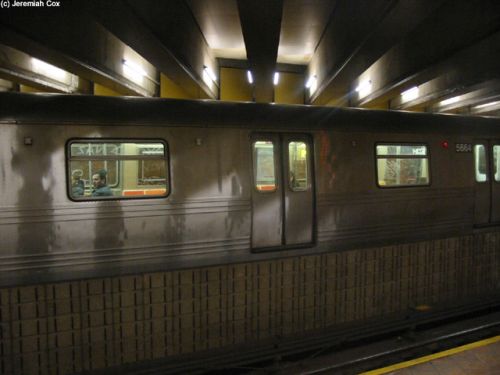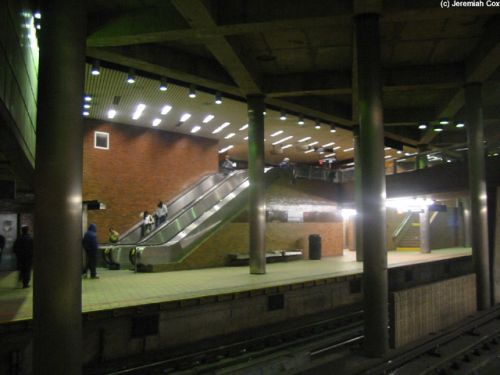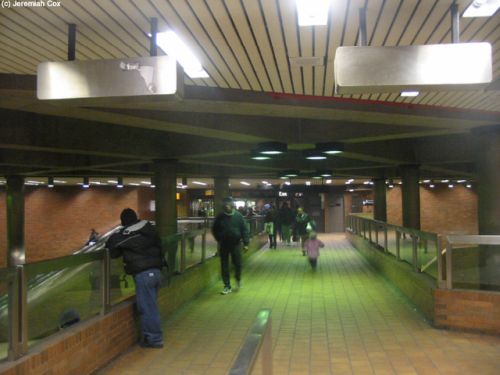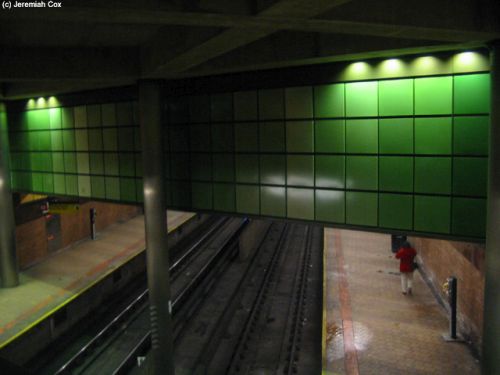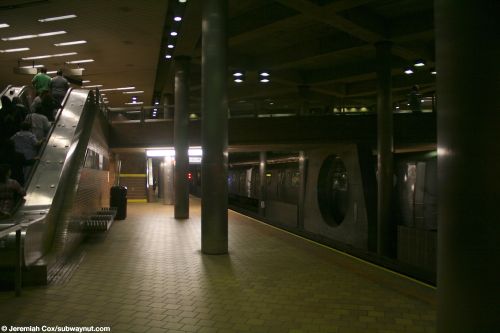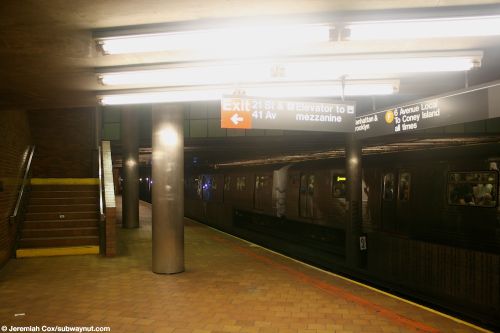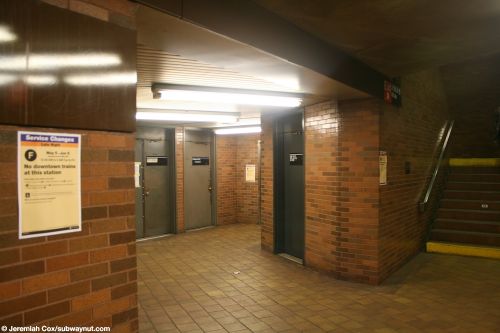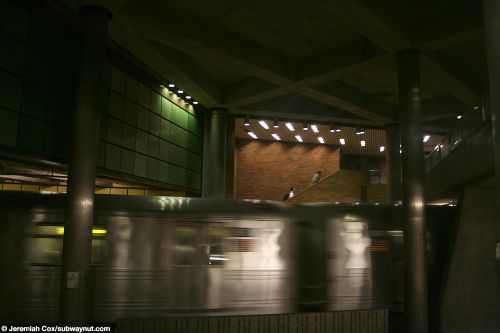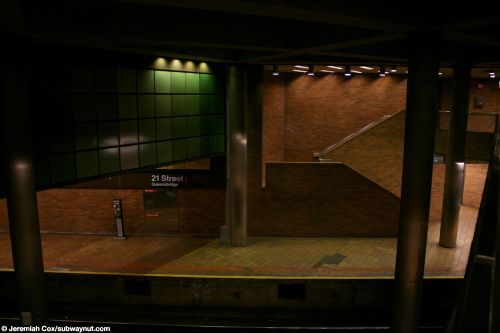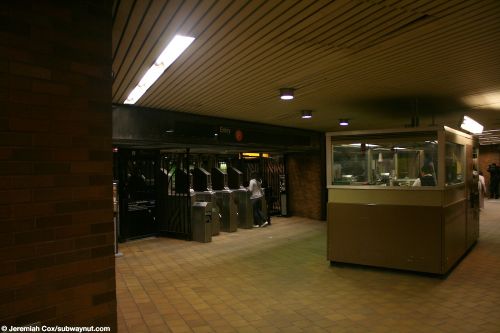





21 Street-Queensbridge is currently just the last or first stop on the F in western Queens. Before the 63 Street Connector opened in 2001, allowing trains to continue beyond the station and reach the Queens Blvd Line, this station was the terminus of the 'tunnel to nowhere' (as it was called when it opened in 1989, ending one stop into Queens, going nowhere else). It was one for twelve years. The station was definitely not designed as a terminal. When the station was one, passengers had to deal with the overpass and there were good signs letting people know what track the next train was running on since the crossover switch is before the station. I still do not understand why the station is not an island platform.
Since 2001 when the 63 Street Connector opened the F train has served the station and there is no reason to see that ever changing. Service through the 63 Street Tunnel and to Queensbridge before 2001 changed a lot over the twelve years since the station opened. For the most part it was as follows: Q (6th Avenue) during weekday rush hours and middays, B on Evenings and Weekends. Late Night service was either a special S-63rd Street Shuttle to 2nd Avenue or Broadway-Lafayette (it ran at all times from July to December 2001 since the Manhattan Bridge flip happened first), or the F (the G was extended to 179 Street-Jamaica when that happened). During 1998 and half of 1999 the track bed of the 63 Street line had to be rebuilt (it was a faulty new design) a Yellow S shuttle operated every 20 minutes to 57th Street/7th Avenue (later extended to 34 St-Herald Square during weekdays, skipping 49 Street via the then unused Broadway Line express tracks) via single-tracking. The B and Q terminated at 57th Street/6th Avenue just like the terminal used before the 63 Street Tunnel Opened.
Starting August 28, 2023 until 'first quarter 2024' the 63 Street tunnel is having its track bed rebuilt, one track at a time, requiring single tracking (why weren't the fixes in 1998 enough? to require just routine maintenance without such a severe disrupton) and service has been severly disrupted at all times. 21 Street/Queensbridge is now a terminus again with no further connections farther east (except via the Q95 shuttle bus to Queensboro Plaza and Queens Plaza) with a single special F Shuttle train operating every twenty minutes to 63 Street/Lexington Avenue, via Roosevelt Island via a single track. During late nights the F Shuttle doesn't operating with only shuttle buses servicing the station, named the Q94 and extended to Roosevelt Island, replacing service there. Regular F trains have been rerouted to the 53 Street tunnel (their tunnel from the start of F train service in 1940 to 2001), and M trains pushed away from Queens Blvd to terminate at 57 Street/6 Avenue (the original purpose of the station for a new weekday train service over the Williamsburg Bridge, with the K/KK originally going to Jamaica-168 Street and later cut back to Eastern Parkway until 1976).
The Station since it is so new, has two side platforms. These are both decently wide. The platform walls as well as the floor are made of brick, towards the top of the platform walls is a line of larger brown sheets, on these are the station signs at regular intervals that say 21 Street-Queensbridge, above this is a thin black strip of metal and above this are yellow squares that take the platform walls up to the station ceiling that is made of concrete. This ceiling is flat, but has ruffles courtesy of probably steel beams inside the concrete. The station's indirect lighting is incorporated in this ceiling. The platforms are columnless. There aren't even any between the tracks. There are only some in the middle of the station when the ceiling becomes double height (This area is almost in the middle of the station but closer to the Eastern end-north, rather than the southern end-south). This is for the bridge across the tracks to the station's exit. On the walls of the double height portion of the ceiling, when it comes down to normal height above the tracks are decorative green squares that provide some nice color variation to the unusual light-colored brick of the station. There are silver, metal colored round columns here also to hold up the ceiling. This is the location of the stations only exit.
From the bridge that provides the overpass and connects the platforms there are separate banks of two escalators (one 'up', one 'down') that lead down to each platform towards their western ends, as well as a staircase towards the eastern ends. Each platform also has its own elevator down from the bridge/overpass area.
The station's only exit is at the Manhattan-bound end of the bridge, beyond the stairs/escalators/elevator down to that platform is a bank of turnstiles, in front of the token booth that lead to a small area outside of fare control. To exit the station there is the street elevator, and a bank of two narrow escalators that lead to the NW corner of 41 Ave and 21 St, right in front of the largest housing project in the city, the Queensbridge Houses. Across 41 Avenue on the NE corner two staircases come up to from the station, one at the corner, and one a bit farther north down 21 Street. All of the station's four means of entry have bricks surrounding them, with the escalators having a glass roof (held up by metal beams) to protect them a bit from the elements. This street escalator could easily be the most exposed escalator to the elements in the entire subway system.
Photos 1-8: February 9, 2004; 9-22: June 4, 2009; 23-49: September 3, 2023;
